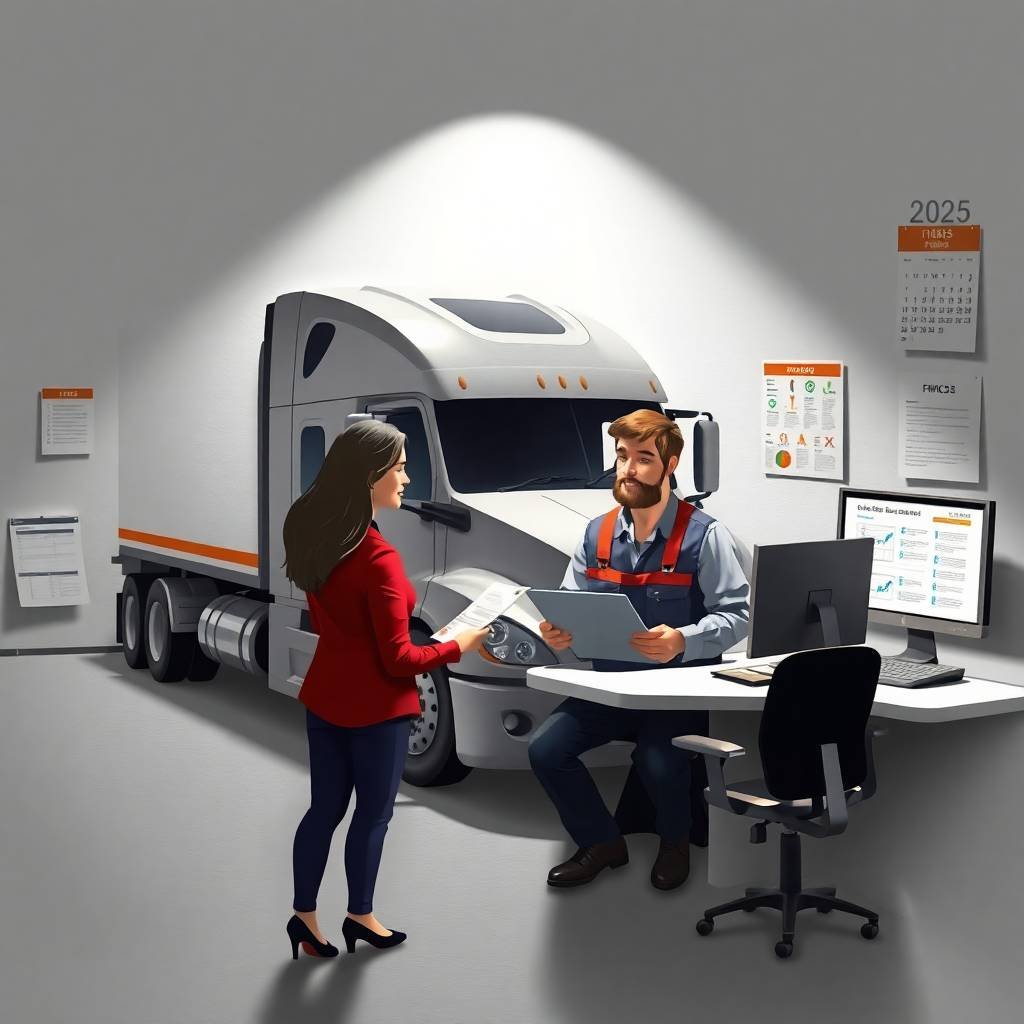1. Why Drug and Alcohol Testing Management Matters More Than Ever in 2025
In 2025, the spotlight on safety, liability, and regulatory enforcement continues to intensify across the transportation industry. For owner-operators and fleet managers, effective drug and alcohol testing management is no longer just a regulatory requirement—it’s a business-critical function that protects operations, drivers, and the public. As federal oversight tightens and digital tracking tools improve, failing to implement a strong testing program can lead to costly consequences.
The FMCSA’s 2025 Regulatory Landscape
The Federal Motor Carrier Safety Administration (FMCSA) has strengthened its position on drug and alcohol enforcement. Carriers are now subject to stricter audits and real-time data sharing via the FMCSA Clearinghouse, making gaps in drug and alcohol testing management far more visible. Noncompliance can trigger out-of-service orders, fines, and CSA score penalties. These changes underscore the need for updated and robust testing programs that align with FMCSA compliance requirements for trucking companies.
Why Owner-Operators Are at Higher Risk
Unlike larger carriers, owner-operators often lack the internal infrastructure to handle complex testing timelines and reporting duties. This makes drug and alcohol testing management even more vital. From enrolling in a random testing consortium to maintaining annual testing quotas, any oversight—intentional or accidental—could derail an entire operation. Resources such as our DOT Compliance Checklist for Owner-Operators are essential to keeping pace with these responsibilities.
Avoiding Common Testing Pitfalls
Many small fleets assume that pre-employment and post-accident testing are enough. However, the FMCSA mandates a full scope of tests: random, reasonable suspicion, return-to-duty, and follow-up. Effective drug and alcohol testing management involves tracking test types, managing paperwork, and preparing for audit inquiries. Carriers that rely on outdated processes risk not just fines, but potential litigation in the event of an accident involving an impaired driver.
Building a Reliable Testing Program
A strong program begins with proper enrollment in a DOT-compliant consortium, ongoing education, and digital recordkeeping. At Truckers Compliance Hub, we help clients implement and monitor their programs with precision. Whether you’re an independent operator or a growing fleet, consistent oversight and third-party expertise are key to success.
You can book a compliance review session to assess your current drug and alcohol program and avoid costly oversights.
Government Enforcement Is Getting Smarter
The Department of Transportation (DOT) and FMCSA are integrating more data across platforms, making it easier to identify non-compliant operators. The U.S. DOT’s Drug and Alcohol Policy and Compliance page makes it clear: noncompliance is not just a risk—it’s a direct path to being shut down. Paired with CSA scoring metrics, ineffective drug and alcohol testing management can seriously threaten your operating authority.
Conclusion
In 2025, successful carriers will be those that take proactive control of drug and alcohol testing management. It’s no longer an administrative formality—it’s an operational necessity. For full compliance support, explore our Driver Qualification File Requirements and get ready to pass any audit with confidence. Prioritize your compliance strategy now to avoid disruptions and maintain your hard-earned authority.

2. Building a Reliable Testing Program: From Enrollment to Enforcement
In the ever-tightening landscape of FMCSA oversight, building a dependable drug and alcohol testing management system is no longer optional. Whether you’re an owner-operator or managing a small fleet, the consequences of noncompliance in 2025 can include audit failures, CSA point penalties, and even suspension of operating authority. Establishing a solid testing program—from initial enrollment to day-to-day enforcement—ensures your business stays legal, safe, and audit-ready.
Start With Proper Enrollment
A reliable drug and alcohol testing management process begins with enrolling in a DOT-approved consortium or setting up your own compliant program. Enrollment is not simply a formality—it’s your gateway to ensuring all mandated testing types are tracked, executed, and logged. According to the FMCSA Compliance Requirements for Trucking Companies, random testing enrollment is legally required for all CDL drivers operating commercial vehicles. The FMCSA also mandates that records of enrollment and test results be readily accessible in case of inspection or audit.
Understand the Testing Categories
Your drug and alcohol testing management program must cover a variety of test types. These include pre-employment, random, post-accident, reasonable suspicion, return-to-duty, and follow-up testing. Each has different triggers and documentation requirements. For example, random testing must be conducted throughout the year using a scientifically valid method. Post-accident testing, meanwhile, must align with DOT guidelines for serious incidents.
Failing to understand these categories can result in costly compliance violations. Our DOT Compliance Checklist for Owner-Operators provides a clear breakdown of each requirement, ensuring that no step is overlooked.
Ongoing Recordkeeping and Reporting
It’s not enough to conduct the tests—accurate recordkeeping is a central element of drug and alcohol testing management. Carriers must retain various documents for different periods. For example, records of negative test results must be retained for one year, while return-to-duty and follow-up testing records must be kept for five years. The Driver Qualification File Requirements page explains what documents belong in each driver’s file.
Additionally, all testing activity must be reported to the FMCSA Drug and Alcohol Clearinghouse. Failure to do so may result in enforcement action or denial of operating authority renewal.
Internal Monitoring and Enforcement
Even after enrollment and documentation, the ongoing success of your drug and alcohol testing management system depends on internal accountability. Ensure supervisors are trained to recognize signs of impairment and initiate reasonable suspicion testing. Regular internal audits help catch errors before an FMCSA compliance review does.
To prepare for such events, reference our How to Prepare for a Compliance Review guide. It provides actionable steps to make your files inspection-ready and compliant.
Get Expert Help Before Mistakes Cost You
Avoiding penalties starts with a professional review of your program. You can book a compliance review session to assess your current drug and alcohol processes and fix any gaps before they result in citations or shutdown orders.
Conclusion
In 2025, drug and alcohol testing management isn’t just about staying legal—it’s about protecting your drivers, your business, and your ability to operate. By enrolling properly, documenting everything, and enforcing policies daily, you position your company for long-term success in a highly regulated industry.

3. Choosing the Right Consortium or Third-Party Administrator (TPA)
In today’s regulatory environment, having a dependable partner for drug and alcohol testing management is no longer optional—it’s essential. Whether you’re an independent owner-operator or manage a fleet, choosing the right consortium or Third-Party Administrator (TPA) can be the difference between a seamless compliance process and costly FMCSA violations. With enforcement expected to tighten in 2025, this decision has never been more critical.
What a TPA or Consortium Actually Does
A consortium or TPA serves as the operational backbone of your drug and alcohol testing management program. These providers coordinate random testing pools, schedule collections, maintain records, report violations to the FMCSA Drug and Alcohol Clearinghouse, and ensure your testing processes meet DOT regulations. More than just administrators, they act as compliance partners tasked with keeping your operation legal and audit-ready.
Why Independent Management Doesn’t Cut It
Many owner-operators believe they can handle drug and alcohol testing management independently. While technically possible, this route exposes you to significant risks. DOT regulations are complex and change frequently. Missteps—such as missed random tests, outdated consortium enrollment, or poor recordkeeping—can result in immediate penalties. The DOT Compliance Checklist for Owner-Operators outlines how overwhelming it can be to manage these duties alone.
Qualities of a Reliable Consortium or TPA
Not all providers are created equal. When evaluating a TPA or consortium for your drug and alcohol testing management needs, look for these essential qualities:
- DOT Certification & Experience: Ensure they are well-versed in 49 CFR Part 382, the primary regulation governing controlled substances and alcohol use in transportation.
- Real-Time Recordkeeping: Providers should offer cloud-based access to testing history, pool selections, and compliance timelines.
- Violation Reporting Support: Your TPA must file required reports to the Clearinghouse on your behalf and help you understand Return-to-Duty processes.
- Audit Support: Strong TPAs help you prepare for inspections. Visit our How to Prepare for a Compliance Review for related documentation tips.
Key Questions to Ask Before You Enroll
When comparing services, ask the following:
- Do you manage both DOT and non-DOT testing pools?
- Are you registered with the FMCSA Clearinghouse?
- Can you provide support during an FMCSA audit?
- What’s your process for scheduling post-accident and follow-up tests?
Their answers will reveal whether their drug and alcohol testing management services are proactive or reactive. You want a partner who anticipates compliance risks, not one who scrambles to fix them afterward.
The Value of Expert Guidance
Still unsure? Schedule a consultation to review your testing program. We’ll help evaluate whether your current TPA is meeting federal standards and explore smarter, more reliable options for 2025.
Stay Ahead of Regulation in 2025
With heightened scrutiny from the DOT and FMCSA, especially concerning violations and disqualifications, you need bulletproof drug and alcohol testing management. Explore our detailed Driver Qualification File Requirements to ensure all aspects of compliance are covered.
Choosing the right consortium or TPA isn’t just a paperwork decision—it’s a compliance safeguard. Make sure yours is built to protect your operation for years to come.

4. Common Compliance Mistakes That Can Cost Owner-Operators Their Authority
In the world of FMCSA oversight, small errors can lead to big consequences. For owner-operators, maintaining active authority isn’t just about keeping wheels turning—it’s about staying ahead of complex compliance requirements. One of the most overlooked yet critical areas is drug and alcohol testing management. Neglect this pillar of safety compliance, and you could quickly find your authority revoked.
Failure to Enroll in a Drug and Alcohol Testing Program
Many new owner-operators assume that once their DOT number is active, they’re good to go. But failing to enroll in a compliant drug and alcohol testing management program is a major misstep. According to FMCSA regulations, enrollment in a testing consortium or TPA is required before the first vehicle ever hits the road. Operating without one can trigger an immediate out-of-service order during a roadside inspection or audit.
Incomplete or Missing Testing Records
Documentation is everything. An effective drug and alcohol testing management system should maintain easy-to-access records for pre-employment, random, post-accident, and return-to-duty tests. If you can’t produce these documents during a compliance review, you risk violations that can compound quickly. The DOT Compliance Checklist for Owner-Operators outlines specific documentation that FMCSA officers often request.
Random Testing Mismanagement
Random testing requirements are time-sensitive and non-negotiable. Failure to respond to selections, use an approved collection site, or follow the correct timeline can all lead to serious penalties. An expert drug and alcohol testing management partner helps monitor deadlines and ensures you meet DOT testing pool quotas year-round. These mistakes are avoidable with the right support system.
Incorrect Reporting to the Clearinghouse
All violations, refusals, and return-to-duty completions must be reported to the FMCSA Clearinghouse by employers or their designated TPAs. Incorrect or missed submissions not only violate federal law but can delay reinstatement after a violation. A compliant drug and alcohol testing management program should offer Clearinghouse integration and violation reporting assistance.
Lack of Education and Training
Many owner-operators underestimate the importance of understanding drug and alcohol testing management requirements. Not knowing when tests are required, how refusals are handled, or how to document results can cost you. At minimum, reviewing our How to Prepare for a Compliance Review article can help you avoid critical gaps in your knowledge.
Fix Compliance Gaps Before They Cost You
Every step of your drug and alcohol testing management process matters—from enrollment to record retention. If you’re unsure whether your current program meets FMCSA standards, it’s time to act. Schedule a compliance review session today to protect your operating authority and stay audit-ready.
Stay Compliant and Confident in 2025
With new enforcement priorities in 2025, the importance of drug and alcohol testing management only continues to grow. Visit FMCSA Compliance Requirements for Trucking Companies to ensure your operation is in full alignment with federal expectations.
For owner-operators, compliance isn’t just paperwork—it’s survival. Avoiding these common mistakes starts with the right knowledge and the right partners.

5. Understanding Your Testing Obligations: Disclaimer vs. Legal Requirement
As we move through 2025, FMCSA enforcement trends are tightening around drug and alcohol compliance. Yet, many owner-operators remain confused about what’s required by law versus what is merely advisory. This confusion often stems from poorly worded disclaimers or third-party interpretations. Clarifying your obligations under drug and alcohol testing management protocols can be the difference between smooth operations and costly violations.
Disclaimers Don’t Equal Compliance
One of the most common compliance errors is mistaking a third-party disclaimer for official guidance. Many testing providers issue disclaimers that suggest certain actions are optional or recommended, without highlighting that FMCSA rules may demand stricter measures. These disclaimers are legal protections for vendors—not binding rules for carriers. For example, while a provider may say you “should” keep random test documentation, the Federal Motor Carrier Safety Administration requires these records to be retained for at least one year. If your drug and alcohol testing management process relies on vague disclaimers, you risk noncompliance.
What FMCSA Legally Requires
FMCSA regulations, under 49 CFR Part 382, clearly define your responsibilities. Enrollment in a drug and alcohol testing management program is mandatory before you operate under DOT authority. You must conduct pre-employment, random, post-accident, reasonable suspicion, and return-to-duty tests according to a strict schedule. Failing to meet these legal standards—regardless of any disclaimer you read—can result in revoked operating authority and civil penalties.
Our FMCSA Compliance Requirements for Trucking Companies guide outlines each obligation in detail, including the difference between best practices and regulatory mandates.
Clearinghouse Compliance Is Non-Negotiable
A critical aspect of drug and alcohol testing management is reporting to the FMCSA Clearinghouse. Every violation, refusal, and return-to-duty status must be recorded accurately. Some TPAs include disclaimers suggesting they may not be liable for submission errors. However, the legal burden falls on the employer—meaning you—as the motor carrier. Misreporting or failing to report can lead to expensive violations and delayed driver eligibility.
Owner-Operators Carry Full Responsibility
Whether you manage your own testing or work through a TPA, the responsibility for compliance is yours. This includes making sure that your drug and alcohol testing management program complies with DOT collection procedures, reporting deadlines, and documentation standards. Our DOT Compliance Checklist for Owner-Operators can help you evaluate your current setup.
Avoiding Costly Assumptions
Never assume a disclaimer protects you from legal consequences. If your compliance materials or service providers blur the lines between suggestion and statute, it’s time for a full review. You can schedule a compliance review session to ensure every part of your drug and alcohol testing management system is aligned with FMCSA requirements.
Stay Informed, Stay Protected
For 2025, knowledge is protection. Take time to review your compliance framework, verify legal requirements, and separate advisory notes from enforceable rules. Visit our resources on Driver Qualification File Requirements and How to Prepare for a Compliance Review to stay ahead.
An informed approach to drug and alcohol testing management could be the key to safeguarding your authority—and your livelihood.

6. Scheduling and Tracking Tests with Confidence: Tools for 2025 Success
Staying ahead of FMCSA audits and maintaining a strong safety profile requires more than just running tests—it demands precision in scheduling and documentation. In 2025, owner-operators and fleet managers face stricter scrutiny than ever before. Efficient drug and alcohol testing management is no longer optional; it’s a regulatory necessity and a competitive advantage.
Why 2025 Demands Smarter Testing Tools
With rising CSA enforcement and random testing quotas increasing, mismanaging your drug and alcohol testing management program can quickly lead to fines or suspension of operating authority. Relying on outdated spreadsheets or manual logs to track testing deadlines is a risk few carriers can afford. Tools designed for 2025 compliance help automate scheduling, track test status, log results, and send real-time notifications—all while keeping your fleet DOT-compliant.
If you’re unsure whether your testing tools meet FMCSA standards, book a compliance consultation today to review your current system.
Digital Calendars and Alerts: Your First Line of Defense
Effective drug and alcohol testing management begins with smart scheduling. Modern compliance platforms allow for automatic calendar integrations that flag upcoming random pool draws, pre-employment tests, and follow-up testing obligations. Alerts can be set based on 49 CFR Part 382 requirements from the Federal Motor Carrier Safety Administration, ensuring you never miss a mandated test window.
If you’re managing multiple drivers or fleets, this type of scheduling precision can drastically reduce your audit risk and support better planning.
Tracking and Documentation You Can Rely On
Tracking test completions, refusals, and results in a secure and centralized system is critical to maintaining compliance. A solid drug and alcohol testing management tool should generate digital logs that include the type of test, result, collector location, and associated driver documentation. These records must be easily exportable in the event of a compliance review or investigation.
Review your current system against our DOT Compliance Checklist for Owner-Operators to ensure you’re meeting all documentation obligations.
Integration with Driver Files and Clearinghouse Reporting
Testing platforms should be integrated with your broader compliance ecosystem. For example, results should sync directly into your Driver Qualification File and be reported to the FMCSA Clearinghouse within mandated timelines. Failure to report within the required window—usually by the close of the third business day—can lead to enforcement actions under DOT policy.
Automation Reduces Human Error
Human oversight accounts for most of the violations in drug and alcohol testing management programs. Automating your scheduling, alerts, reporting, and documentation reduces this risk dramatically. You can also layer compliance tech with training modules and testing site locators to streamline daily operations.
To get help selecting or upgrading your testing system, explore our full guide on FMCSA Compliance Requirements for Trucking Companies.
Don’t Let Testing Gaps Threaten Your Authority
Testing compliance is one of the most common FMCSA audit failures. If you’ve missed deadlines, misplaced results, or misunderstood random pool procedures, now’s the time to fix it. Let our team help you build a bulletproof strategy for drug and alcohol testing management that protects your business long-term.
Secure your testing calendar for 2025 and beyond—schedule your review session now.

Who is required to participate in a DOT drug and alcohol testing program?

Any commercial driver operating a vehicle with a GVWR of 26,001 lbs or more, or transporting hazardous materials, must be enrolled in a DOT-compliant drug and alcohol testing program—even if they’re an owner-operator.
What types of drug and alcohol tests are required by the FMCSA?

Required tests include pre-employment, random, post-accident, reasonable suspicion, return-to-duty, and follow-up testing. In 2025, oral fluid testing is now officially recognized alongside urine testing.
How often are random drug and alcohol tests conducted?

In 2025, the FMCSA requires a minimum random drug testing rate of 50% and an alcohol testing rate of 10% annually for covered drivers. Random selections must be scientifically valid and spread throughout the year.
What are the consequences of failing to comply with drug and alcohol testing rules?

Non-compliance can lead to DOT fines, out-of-service orders, and even revocation of your operating authority. A single missed test or paperwork error can trigger an audit or enforcement action.
How does your service help with drug and alcohol testing management?

We enroll you in a compliant testing consortium, manage your random selections, handle reporting, and maintain proper documentation. We also guide you through post-accident protocols and help with audit preparation.
